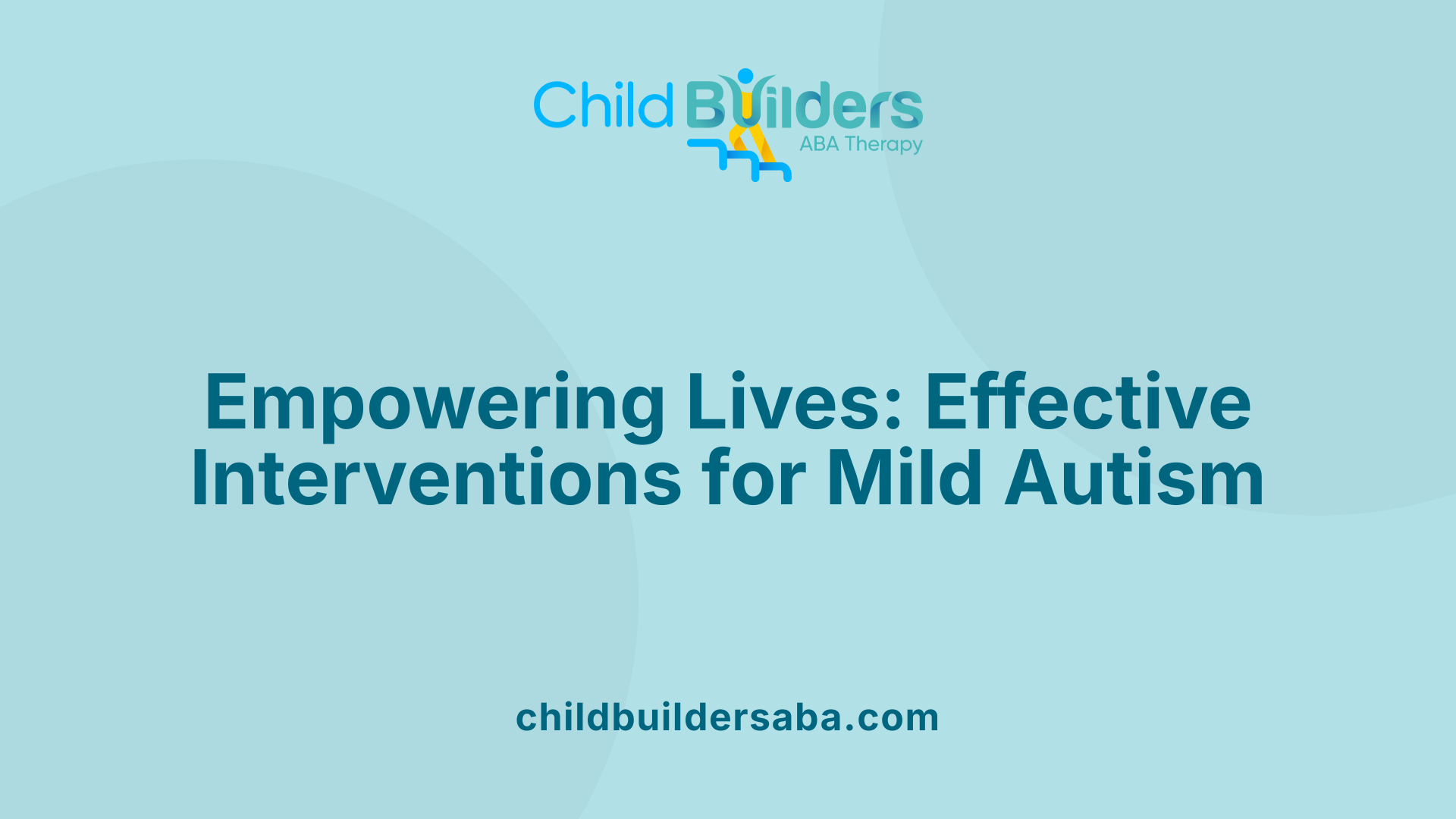Mild Autism

A Closer Look at Mild Autism and Its Characteristics
Mild autism, often classified as Level 1 autism spectrum disorder (ASD), is a form of neurodevelopmental variation with distinctive behavioral and social features. It involves subtle challenges that can often be masked, making awareness, early identification, and support crucial for fostering independence and quality of life. This article explores the traits, diagnosis, causes, and support strategies related to mild autism, aiming to provide clarity and guidance for individuals, families, and professionals.
Severity Levels of Autism Spectrum Disorder: Differentiating the Spectrum

How do severity levels of autism spectrum disorder differ, specifically focusing on Level 1 (mild) autism?
The DSM-5 classifies autism spectrum disorder (ASD) into three levels based on the severity of symptoms and support needs. These levels help describe the extent to which individuals can function independently and the support they require.
Level 1, often called 'mild' autism or high-functioning autism, involves noticeable challenges mainly in social communication and flexible behavior, but individuals can often function with some support. They may find it difficult to initiate social interactions or deal with changes in routines, and organizational challenges are common. Despite these difficulties, many individuals with Level 1 autism can live independently and hold jobs, although they might need assistance in social or organizational tasks.
In contrast, Level 2 autism presents with more significant social and behavioral deficits. These individuals require substantial support to manage daily life, struggle more with social cues, and often have more persistent and restrictive behaviors.
Level 3 represents the most severe end of the spectrum. These individuals exhibit severe deficits in verbal and non-verbal communication, minimal social responses, and require very substantial support. They often face profound challenges with independence and daily functioning.
Understanding these distinctions is essential for tailoring support and interventions suited to each individual's needs, promoting better outcomes and quality of life across the spectrum.
| Level | Description | Support Needs | Typical Daily Functioning | Additional Notes |
|---|---|---|---|---|
| Level 1 | Mild autism / High-functioning | Low support, some assistance | Can often live independently, needs help in social cues and routines | May mask signs easily; strengths in focus and memory |
| Level 2 | Moderate autism | Substantial support | Needs assistance in daily activities, more evident social difficulties | Greater difficulty adapting to change; more restricted interests |
| Level 3 | Severe autism | Very substantial support | Dependent on others for most activities | Significant challenges in communication and behavior management |
This classification guides clinicians and caregivers in providing appropriate interventions and support systems for individuals across the autism spectrum.
Recognizing the Traits and Symptoms of Mild Autism

What are the typical traits and symptoms of someone with mild autism?
Individuals with mild autism, often called Level 1 Autism Spectrum Disorder (ASD), usually display subtle but noticeable differences in social interaction and communication. They might find it challenging to interpret social cues like facial expressions, body language, or tone of voice. While their verbal skills are often well-developed, they may struggle in group settings, feeling overwhelmed or anxious during social interactions.
Deep focus on specific interests or hobbies is common among these individuals. They might become deeply engaged in a narrow range of topics, sometimes to the point of obsession. Sensory sensitivities are also prevalent—some are overly sensitive to sounds, textures, lights, or smells, which can cause discomfort or distraction in everyday environments.
Behaviorally, many with mild autism prefer routines and may engage in repetitive behaviors such as hand-flapping, rocking, lining up objects, or repeating phrases. Change or unpredictability can cause significant anxiety, making transitions or new experiences stressful.
Despite many traits being masked or hidden, these individuals often experience genuine difficulties with flexibility and executive functioning—affecting planning, organizing, or managing daily tasks. They might also have trouble expressing their emotions clearly or understanding others’ feelings.
While they might outwardly appear socially typical and sometimes adept at masking their challenges, subtle signs like difficulty adjusting to new routines, stress in social environments, or intense interests can be telling indicators of mild autism.
Many people with mild autism live independently, especially with support and understanding tailored to their strengths. Early identification and intervention—including behavioral therapy, social skills training, and sensory supports—can significantly enhance their ability to navigate social situations and improve overall quality of life.
Diagnosis and Assessment Processes for Mild Autism

How is mild autism diagnosed, and what does the assessment process involve?
Diagnosing mild autism involves a careful and thorough process that combines developmental screening, behavioral observations, and standardized diagnostic tools. It begins with routine developmental monitoring during regular healthcare visits. At specific ages, typically around 18 and 24 months, screening questionnaires such as the Modified Checklist for Autism in Toddlers (M-CHAT) are used to identify early signs of autism.
If concerns arise, a team of specialists—including psychologists, developmental pediatricians, neurologists, or child psychiatrists—conducts a detailed evaluation. They review the child's developmental history, focusing on milestones like speech, social interactions, and play behaviors. Direct observations of the child's behavior are essential, providing insights into social communication skills, repetitive behaviors, and sensory sensitivities.
Standardized assessment tools such as the Autism Diagnostic Observation Schedule (ADOS-2) and the Autism Diagnostic Interview-Revised (ADI-R) are widely used. These instruments help clinicians objectively evaluate social interaction, communication, and repetitive behaviors. The combined results from these assessments guide diagnosis according to the criteria outlined in DSM-5.
Genetic testing may also be recommended to look for associated genetic conditions, although no single medical test can confirm autism. The process emphasizes behavioral and developmental information, which is crucial for early intervention planning.
Overall, the assessment process is comprehensive yet individualized, tailored to each child's needs to ensure an accurate diagnosis and appropriate support strategies.
Causes and Risk Factors Associated with Mild Autism
What are the causes and risk factors associated with mild autism?
The origins of mild autism are complex and not yet fully understood, involving a combination of genetic and environmental influences that affect brain development. Genetic factors play a significant role, with research estimating that between 60% and 90% of autism's risk is linked to heredity. This includes inherited gene variations, spontaneous mutations, and a family history of autism or other neurodevelopmental conditions.
Environmental influences during prenatal and early life stages also contribute to the likelihood of developing mild autism. Advanced parental age, particularly older fathers and mothers, has been associated with increased risks due to potential genetic mutations and epigenetic changes. Prenatal exposures to pollutants, chemicals, and toxins such as heavy metals, pesticides, and certain industrial substances may interfere with normal brain development.
Maternal health conditions, including diabetes, immune disorders, and infections during pregnancy, are linked to higher autism risks. Complications during birth, such as preterm delivery, low birth weight, or oxygen deprivation, can impact neurological development and increase susceptibility.
Some factors may have protective effects; for example, adequate prenatal vitamin intake, especially folic acid, has been associated with a reduced risk. Conversely, exposure to harmful environmental toxins may elevate the risk.
Overall, multiple interacting factors during critical windows of development contribute to the emergence of mild autism. While some risks can be mitigated through healthcare and lifestyle choices, many factors remain outside direct control, emphasizing the importance of ongoing research and early detection.
Learning and Communication in Individuals with Mild Autism
Can individuals with mild autism learn to communicate effectively?
Many people with mild autism have the potential to develop strong communication skills, especially when they receive early and appropriate support. While their initial abilities may be limited, targeted interventions can make a significant difference.
Support strategies such as speech therapy help improve both verbal and non-verbal communication. Speech-language pathologists work with individuals to develop expressive language, comprehension skills, and social communication. Additionally, augmentative and alternative communication (AAC) systems like Picture Exchange Communication System (PECS), sign language, and communication devices can assist those who struggle with speech.
Early intervention is particularly effective. When therapy begins during early childhood, it can help individuals learn to express their needs, thoughts, and feelings more clearly. These programs focus on teaching social cues, turn-taking, and emotional understanding.
While some individuals with mild autism might still find social interactions challenging or prefer alternative communication methods, many make substantial progress. Tailored approaches, consistent practice, and supportive environments are crucial.
In summary, with the right tools and support, many individuals with mild autism can achieve effective communication, leading to better social connections and independence. Their capacity to learn and adapt can be nurtured through systematic and patient intervention programs, fostering meaningful engagement with the world around them.
Effective Treatments and Supportive Interventions

Are there effective treatments or interventions for mild autism?
Yes, there are several supportive strategies and therapies that can help individuals with mild autism spectrum disorder (ASD). Early identification and intervention are crucial for better outcomes. The primary goal of these interventions is to improve social, communication, and behavioral skills, enabling individuals to lead more independent and fulfilling lives.
The most widely recognized evidence-based therapies include applied behavior analysis (ABA), social skills training, speech therapy, and occupational therapy. Each of these approaches is tailored to meet the unique needs of the individual. For example, ABA focuses on reinforcing positive behaviors and reducing challenging behaviors through structured teaching methods.
Speech and language therapy can help improve communication skills, including understanding social cues and expressing thoughts clearly. Occupational therapy assists with sensory sensitivities and daily living skills, helping individuals manage their environment and develop practical skills.
Creating an inclusive environment involves educational support and personalized plans that incorporate visual supports, routine schedules, and safe spaces. Such strategies help reduce anxiety and provide a sense of stability.
| Therapy Type | Main Focus | Typical Applications |
|---|---|---|
| Behavioral Therapy (ABA) | Skill development, behavior modification | Language skills, social interactions, daily routines |
| Pivotal Response Treatment (PRT) | Motivation and communication improvements | Play skills, social engagement, adaptive behaviors |
| Speech Therapy | Language and communication skills | Expressive language, understanding social cues |
| Occupational Therapy | Sensory integration and daily skills | Handling sensory sensitivities, motor skills |
In summary, these tailored interventions are effective at helping those with mild autism to develop their strengths and manage difficulties. Although there is no cure, ongoing support and therapies can make a meaningful difference in quality of life.
If seeking help for mild autism, consulting with specialists such as developmental pediatricians or therapists can facilitate the planning of a comprehensive, personalized support plan. This proactive approach ensures that individuals receive the right kind of assistance to thrive.
Debunking Myths and Clarifying Misconceptions about Mild Autism

What are common misconceptions about mild autism?
A prevalent falsehood is that mild autism is not serious or that it doesn't last lifelong. However, individuals with mild autism can still experience considerable difficulties in social situations, communication, and daily functioning, and they can benefit from ongoing support.
Another widespread myth is that autism arises from parenting styles or vaccinations. Scientific research, however, shows autism as a neurodevelopmental condition that is largely influenced by genetics and prenatal environmental factors. It is present from early in life and is not caused by any form of parental behavior or immunizations.
Some believe autism is an epidemic, but the increased numbers of diagnoses are primarily due to improved recognition, expanded diagnostic criteria, and greater awareness rather than a rapid rise in actual cases.
Stereotypes also include the idea that all autistic individuals are unable to communicate or lack feelings of empathy. In reality, autistic people display a broad range of abilities, emotions, and capacities for forming meaningful relationships. Many develop their unique ways of interaction and express emotional responses.
A crucial point is that autism exists on a spectrum, encompassing a wide variety of symptoms and severities. It is not a disease to be cured but a different way the brain develops and functions. Recognizing this diversity helps promote acceptance and understanding.
The spectrum nature of autism
Autism spectrum disorder (ASD) covers a broad array of behaviors and degrees of severity. It includes conditions like Asperger’s syndrome, PDD-NOS, and autistic disorder, each with distinct but overlapping traits.
People on the spectrum can have diverse learning styles, communication abilities, and sensory processing differences. Some may excel academically or have special talents, while others face significant hurdles. This variability emphasizes the importance of personalized approaches for support and intervention.
Autism as a lifelong neurodevelopmental condition
Autism is a lifelong condition affecting how the brain develops and processes information. The manifestations can change with age, but the core characteristics—social communication differences, repetitive behaviors, and sensory sensitivities—persist.
Early diagnosis and intervention are crucial, as they enable individuals to develop skills and strategies to manage challenges effectively. However, many adults with mild autism go undiagnosed, often because their symptoms are subtler or they have learned to mask them.
Understanding autism as a lifelong neurodevelopmental variation rather than a disease helps foster a more inclusive environment where autistic individuals are appreciated for their unique perspectives and strengths.
| Myths about Mild Autism | Facts | Additional Clarifications |
|---|---|---|
| Not a lifelong condition | Autism persists throughout life | Support and adaptation improve quality of life |
| Caused by bad parenting or vaccines | Caused by genetics and prenatal factors | No link to parenting or vaccinations |
| All autistic people can't communicate | Autism varies widely | Skills and capabilities are highly individual |
| Autism is an epidemic | Better detection and awareness | Not an actual increase in cases |
| Autism is a disease to cure | It is a neurodiversity | Supports focus on acceptance and adaptation |
Understanding these misconceptions equips society to better support and include autistic individuals, recognizing their abilities, challenges, and need for acceptance.
Supporting and Embracing People with Mild Autism
Understanding mild autism as a spectrum with diverse traits and needs is vital for fostering acceptance, providing timely support, and enabling individuals to thrive. Recognizing early signs, promoting inclusive environments, and debunking misconceptions allow individuals with mild autism to live fulfilling, independent lives while contributing their unique perspectives and strengths to the community.
References
- Autism spectrum disorder - Symptoms and causes - Mayo Clinic
- Understanding Mild Autism - Verywell Mind
- Signs and Symptoms of Autism Spectrum Disorder - CDC
- Mild Autism in Adults: Can You Really Be “Mildly Autistic”?
- Autism Spectrum Disorder (ASD) Symptoms & Causes
- Signs of autism in adults - NHS
- Can a child be "slightly autistic"? - Bluesprig Autism
- What Is Autism Spectrum Disorder? - American Psychiatric Association
- ASD levels of severity - Autism Speaks
- What is Mild Autism? Understanding Symptoms & Treatments



.jpg)

































































































